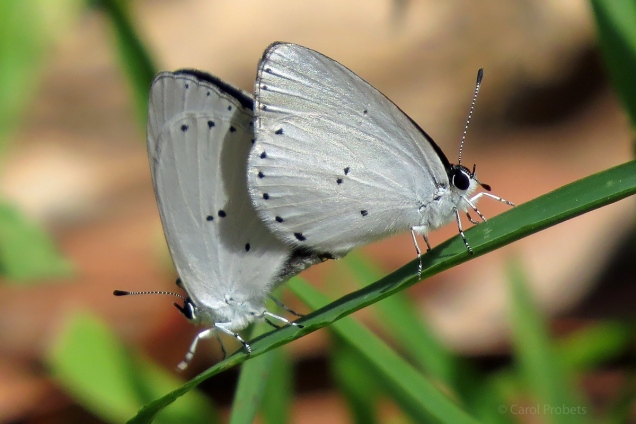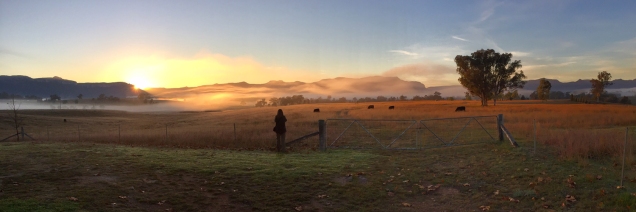In June and July when the days are short and the air has a frosty bite, the Blue Mountains bush erupts in a spectacle of golden yellow sprinkled through the understorey like splashes of sunshine. Continue reading
Refugees from the drought

It’s one of the paradoxes of birding that you often see more birds when conditions are dry, at least in the near-coastal regions where the majority of us live. The reason is that many of Australia’s nomadic birds leave the driest areas during drought and move toward the coast to take refuge in better watered areas. As ephemeral lakes and rivers dry up, water birds are forced to congregate in the remaining permanent waterholes, often travelling hundreds of kilometres to do so. Bush birds leave their usual territories as there are few insects and scant flowering in the parched conditions. Sedentary birds might fail to breed or even die, but those species with a tendency to move long distances can end up almost anywhere in the country. Continue reading
Treecreeper feeding on Xanthorrhoea nectar

Last weekend (6th August) I visited Booderee National Park, one of the most beautiful and unspoilt parts of the NSW south coast. Long straight flower spikes had shot up like spears from the grass-trees (Xanthorrhoea sp.) and tiny star-like flowers were opening to form a delicate white mantle on their surface. These flowers are highly attractive to nectar-feeding birds and insects; on this occasion it was mostly Yellow-faced Honeyeaters and Silvereyes converging on them. Continue reading
Winter musings

Have you noticed birds singing in the past couple of weeks? 21st June was the solstice — the shortest day of the year if you’re south of the Tropic of Capricorn, and a significant time in nature. The shift from days getting shorter to days getting longer triggers certain changes in animals and plants. For some Australian birds, nesting behaviour begins soon after the winter solstice. Birds that didn’t migrate may already be re-establishing their territory and this means an increase in birdsong (territorial singing as opposed to the generally shorter calls). Some birds start building their first nest of the season, heralding the frenzy of breeding activity that lies ahead. Others are still in their wintering grounds. Continue reading
Life and blogging
Time has slipped away and I realise it’s eight weeks since my last post. Be assured this is not due to apathy, but a combination of circumstances including the hospitalisation of a close, elderly family member, not having ready access to my books and photo files (for reasons too complicated to explain here), and juggling the additional responsibilities with tours and blocks of field work, preparing presentations, and all the extra travelling. As soon as things settle down again I’ll be writing and posting more often, including some of the topics I’ve previously promised to follow through on (I still haven’t forgotten those Western Australian orchids!). I have other half-finished articles mostly written in cafés on my laptop, just waiting for a final fact-check, edit and photos. Like a Wandering Albatross egg, they’re having a long incubation!
Nature provides a rich, never-ending supply of things to write about, so my blogging schedule ends up being whenever I have time to create the words and pictures. I deliberately don’t promise a regular timetable of posting because I know life often intervenes. I admire those people who can produce good posts in the blink of an eye, but I’m certainly not one of them. It is however one of my goals to become more like that. Continue reading
A meal fit for a kookaburra

I first noticed this kookaburra because a Grey Butcherbird was sitting on the branch above, watching it intently. Not much escapes a bird’s attention. The kookaburra had caught a rat and was struggling to stay in balance with such large prey dangling from its bill. Continue reading
Ghost Fungus: the sequel

Last year I wrote about the cluster of bioluminescent Ghost Fungus (Omphalotus nidiformis) growing on a dead tree in the backyard of the house where I live (see Glow-in-the-dark fungi). This year we had an exceptionally wet March creating great conditions for fungi of all sorts. And guess what — those ‘ghosts’ were back in droves! But strangely, I didn’t recognise them at first. Continue reading
Drama at the cabin

It was a sultry night, especially for March. Tiny flying insects kept landing on my laptop’s screen, attracted to its light as I sorted through the day’s photos. I’d settled into my cabin for the night on an isolated bush property in the Capertee Valley. The rocky escarpment rising steeply behind formed an imposing presence, even in the darkness of a moonless night. Continue reading
Before the migration: introducing the Yellow-faced Honeyeater

A spectacular annual migration will begin in late March as Yellow-faced Honeyeaters start streaming northward up the coast and tablelands of south-eastern Australia. The waves of travelling birds will continue for 6-8 weeks on suitable fine-weather mornings. Already, observant birders might have noticed small restless groups moving about. Continue reading
Encounter with a Striped Marsh Frog
The rain has washed away the stifling summer heat. Everything’s glistening and frogs are moving around, finding new habitat. The other day, as I walked along a quiet residential street in the Blue Mountains, I noticed a rather winsome frog sitting on the road. By lucky coincidence I had my camera with me.
If anyone was watching through their window I don’t know what they must have thought, but you can’t get a ground-level photo of a frog without lying flat on the ground.

The claustrophobic birds that nest in dangerous places

Driving along a quiet gravel road in the country, you notice a small bird with sleek, pointed wings fly up in front of the car. Luckily, you don’t hit it. The following day the same thing happens, in exactly the same place. You stop the car and look at the spot it flew from. At first you’ll see nothing. But if you search carefully you might find two or three well camouflaged eggs in a scrape on the shoulder of the road. With their elaborate pattern of flecks and lines, they look just like the stones they sit amongst. Continue reading
Why do some currawongs have striped tails?
Every year around January or February, someone usually asks me about a strange currawong they saw with a striped tail. If you’re familiar with currawongs you’ll know they don’t normally have stripes or spots down the tail, in the way that cuckoos and kookaburras do. So what’s the story with the ones that appear in summer, tail all stripy like the bird in the photo below? The explanation is quite simple.

Transitions
Sunrise and sunset, like any time of transition, are special moments. One of my favourite sunsets of 2016 was in September at Fivebough Swamp on the outskirts of the NSW town of Leeton. Continue reading
Butterfly pas de deux

Last week I found myself at the ballet. It wasn’t exactly a traditional ballet; it took place in the open air. The venue was a forest in the lower Blue Mountains, the stage was a blade of grass, and the dancers stood less than 20 millimetres tall. The plot, however, was a classic love story and the choreography was perfect. Continue reading
The lure of the bottlebrush
When I visited a farm in November to survey the birdlife, I expected a tranquil afternoon in nature. But nature had other ideas.

I walked onto the survey site to be greeted by clamour and movement everywhere. The cackling of dozens of Noisy Friarbirds filled the air with a chaotic din as they chased each other in and out of the bushes. Emerald green Musk Lorikeets scrambled through the foliage, randomly exploding into flight with breakneck speed and a sudden screech. Their young followed, calling wheezily, insistently. Wings fluttered and tails spread in an irresistible signal for their parents to feed them. Continue reading
Function and artistry: an assortment of birds’ nests
Spring is a season of intense activity — not only for our fauna and flora but for me, as this is when I’m busiest leading tours, walks, and carrying out bird surveys. It’s frustrating that the season when I have least time to write is the very time there’s the most to write about. On the plus side, I’m outside seeing it all first hand! I’ll try to make up for my recent lack of posts with plenty of summer offerings, including looks at some of the interesting things I’ve seen during the past three months.

It hasn’t been hard to find birds nesting and feeding young. For many species this continues into the summer months. Australian birds tend to have long nesting seasons (and smaller clutch sizes) compared to cooler-climate northern hemisphere species (see Ford 1989). This allows them to raise two and sometimes more broods, or at least have another try if the first one fails — which happens often. A nest success rate of less than 50% is not uncommon among small birds. This might be due to predation of the eggs or young, parasitism by cuckoos, an unexpected shortage of food, severe weather, bushfire or human interference. It’s amazing small birds manage to reproduce at all when you think of the many dangers they face.
Let’s take a look at some of the nests I’ve found during my travels this season, plus a couple of favourites from last year thrown in. Each is ingenious in its own way. Continue reading
Some wildflowers of Western Australia

How lucky was I, being asked to guide a birding tour to the south-west of Western Australia in September this year. As it happens, the region is also famed for its rich and diverse flora, and we were visiting in the middle of wildflower season! Continue reading
Migration of the Painted Ladies

Masses of orange-brown butterflies are currently moving through the Blue Mountains, and no doubt other parts of south-eastern Australia. These are Australian Painted Ladies, Vanessa kershawi, flying south (or south-west) on their spring migration. Continue reading
A kestrel’s snack
Katoomba’s Phantom Falls
The Blue Mountains worked their magic yesterday morning. The Phantom Falls were flowing, an event which only happens a few times a year when conditions are just right.





